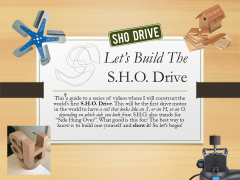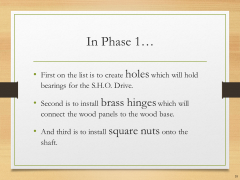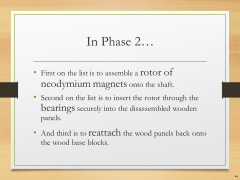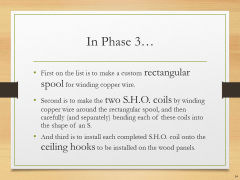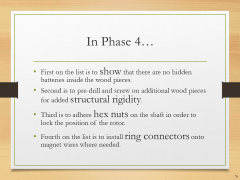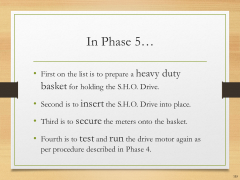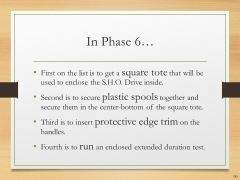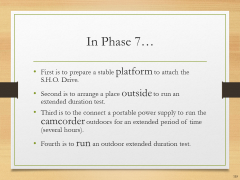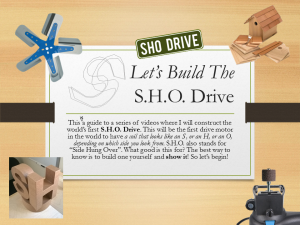|
|
| (34 intermediate revisions by the same user not shown) |
| Line 1: |
Line 1: |
| | + | {{#seo: |
| | + | |title=April 2016 Presentation @ Sho Drives Wiki |
| | + | |titlemode=replace |
| | + | |keywords=electricity,magnetism,motor,generator |
| | + | |description=Presenting the S.H.O. Drive! PNG and PowerPoint available. |
| | + | }} |
| | + | {{DISPLAYTITLE:April 2016 Presentation}} |
| | + | [[File:Let's Build the S.H.O. Drive! - Slide 001 of 176.png|thumb|link=File:Let's Build the S.H.O. Drive!.pptx|<div style="float: right">[http://www.sho.wiki/images/Let%27s_Build_the_S.H.O._Drive%21.pptx ''Let's Build the S.H.O. Drive!.pptx''] (68 MB)</div>]] |
| | + | '''Let’s Build The S.H.O. Drive!'''<br>• This <sup><big>'''''is'''''</big></sup> a guide to a series of videos where I will construct the world’s first S.H.O. Drive.<br>• This will be the first drive motor in the world to have a coil that looks like an S, or an H, or an O, depending on which side you look from.<br>• S.H.O. also stands for “Side Hung Over”.<br>• What good is this for? The best way to know is to build one yourself and show it! So let’s begin! |
| | | | |
| − | <center>
| + | {{Presentation Explorer}} |
| − | ==Introduction==
| + | {{Site map}} |
| − | {{Gallery | + | |
| − | |width=360
| + | [[Category:Presentation]] |
| − | |align=center
| + | [[Category:Replication Station]] |
| − | |lines=10
| + | |
| − | |footer=
| + | |
| − | |Let's Build the S.H.O. Drive! - Slide 001 of 176.png||'''Let’s Build The<br>S.H.O. Drive'''<br>• This <sup><big>'''''is'''''</big></sup> a guide to a series of videos where I will construct the world’s first S.H.O. Drive. This will be the first drive motor in the world to have a coil that looks like an S, or an H, or an O, depending on which side you look from. S.H.O. also stands for “Side Hung Over”. What good is this for? The best way to know is to build one yourself and show it! So let’s begin!
| + | |
| − | |Let's Build the S.H.O. Drive! - Slide 002 of 176.png||'''Measuring Devices'''<br>''(Equipment)''<br>• This project involves many measuring devices, including analog and digital thermometers, a laser tachometer, a Milli-Ohm meter, an RMS meter, a LC meter, an Anemometer, a magnetic pole detector, and a metal detector.
| + | |
| − | |Let's Build the S.H.O. Drive! - Slide 003 of 176.png||'''Rechargeable Batteries'''<br>''(Energy)''<br>• Some of these devices come with non-rechargeable batteries. When these run out, they will need to be replaced.<br>• Where possible, rechargeable batteries will be used after the old batteries are used up.
| + | |
| − | |Let's Build the S.H.O. Drive! - Slide 004 of 176.png||'''Non-Rechargeable Batteries'''<br>''(Energy)''<br>• Some of the measuring devices require watch-type batteries, so for these devices, non-rechargeable batteries will be used.
| + | |
| − | |Let's Build the S.H.O. Drive! - Slide 005 of 176.png||'''Fuses'''<br>''(Equipment)''<br>• Most multimeters have built-in fuses. These fuses are designed to burn out when overheated due to excessive current.<br>• So as a matter of preparation, I have purchased compatible replacement fuses.
| + | |
| − | |Let's Build the S.H.O. Drive! - Slide 006 of 176.png||'''20 Amp Fuses'''<br>''(Equipment)''<br>• For 20 Amp protection, I purchased a 2-pack of Bussmann BP/ABC-20 20 Amp Fast Blow Fuses from Bussmann via Amazon.com
| + | |
| − | |Let's Build the S.H.O. Drive! - Slide 007 of 176.png||'''200 Milliamp Fuses'''<br>''(Equipment)''<br>• For 200 mA protection, I purchased a 5-pack of Bussmann GMA 200mA Fast-Blow Fuses from Divine Lighting via Amazon.com
| + | |
| − | |Let's Build the S.H.O. Drive! - Slide 008 of 176.png||'''Fire Extinguisher'''<br>''(Equipment)''<br>• In a worst-case scenario, the project may catch on fire due to overheating.<br>• To reduce the losses associated with such a fire, I must have a fire extinguisher at hand.
| + | |
| − | |Let's Build the S.H.O. Drive! - Slide 009 of 176.png||'''Fire Extinguisher'''<br>''(Equipment)''<br>• So for basic safety requirements, I purchased the Amerex B500, 5lb ABC Dry Chemical Class A B C Fire Extinguisher from Amerex via Amazon.com
| + | |
| − | |Let's Build the S.H.O. Drive! - Slide 010 of 176.png||'''Safety Gear'''<br>''(Equipment)''<br>• For safety, I purchased SAS safety goggles, an SAS First Aid Kit, and FastCap Skins Gloves, which I found in extra large.<br>• I purchased these and more at a wood-working specialty store called Woodcraft.
| + | |
| − | |Let's Build the S.H.O. Drive! - Slide 011 of 176.png||'''Safety Gear'''<br>''(Equipment)''<br>• Since my wood-working operations will be limited to sanding and drilling small holes and grooves, I will use a Western Safety Dust and Particle Mask so as to not inhale any saw dust.<br>• I purchased this from a Harbor Freight Tools store.
| + | |
| − | |Let's Build the S.H.O. Drive! - Slide 012 of 176.png||'''Visual Evidence'''<br>''(Protocols)''<br>• After the S.H.O. Drive is built, tests will follow.<br>• The plan is to run extended duration tests, some which will run for hours, and others for days.<br>• An appropriate video recording device is required to provide a visual record for these tests as they happen.
| + | |
| − | |Let's Build the S.H.O. Drive! - Slide 013 of 176.png||'''Camcorder'''<br>''(Recording)''<br>• To provide evidence for these tests, I have purchased a Canon VIXIA HF R60 Camcorder from Canon via Amazon.com
| + | |
| − | |Let's Build the S.H.O. Drive! - Slide 014 of 176.png||'''Camcorder'''<br>''(Recording)''<br>• This camcorder can record up to 12 hours at normal recording speed and also has a time-lapse function to record video over several days, or more.<br>• It can capture video at 60 progressive frames per second.
| + | |
| − | |Let's Build the S.H.O. Drive! - Slide 015 of 176.png||'''Memory Card'''<br>''(Recording)''<br>• In order to record and save very long videos, I purchased the Transcend 128GB SDXC Class 10 UHS-1 Flash Memory Card from Transcend via Amazon.com
| + | |
| − | |Let's Build the S.H.O. Drive! - Slide 016 of 176.png||'''Adjustable Clamp Mount'''<br>''(Recording)''<br>• To record video at the desired angle, I have purchased the 13.4" Smatree Adjustable Jaws Flex Clamp Mount from Smatree via Amazon.com
| + | |
| − | |Let's Build the S.H.O. Drive! - Slide 017 of 176.png||'''Wide Angle Lens Kit'''<br>''(Recording)''<br>• In order to capture a wider angle of view in the video, I purchased a Wide Angle Lens Kit from ButterflyPhoto via Amazon.com<br>• The included .43x Wide Angle Lens provides a better approximation of human vision.
| + | |
| − | }} | + | |
| − | <div style="clear:both"></div>
| + | |
| − | ==Phase 1==
| + | |
| − | {{Gallery | + | |
| − | |width=360
| + | |
| − | |align=center
| + | |
| − | |lines=10
| + | |
| − | |footer=
| + | |
| − | |Let's Build the S.H.O. Drive! - Slide 018 of 176.png||'''In Phase 1…<br>• First on the list is to create holes which will hold bearings for the S.H.O. Drive.<br>• Second is to install brass hinges which will connect the wood panels to the wood base.<br>• And third is to install square nuts onto the shaft.
| + | |
| − | |Let's Build the S.H.O. Drive! - Slide 019 of 176.png||'''2 Barn Birdhouse Kits'''<br>''(Phase 1 Parts)''<br>• The wood panels I will be using will come from 2 SawDust Bros. Birdhouse Kits which I obtained from Woodcraft.<br>• Why birdhouse kits? Well each birdhouse kit is packed with many pieces of wood of various sizes, which I may use in the future.
| + | |
| − | |Let's Build the S.H.O. Drive! - Slide 020 of 176.png||'''Saving Time'''<br>''(Protocols)''<br>• But the main reason why I purchased two Birdhouse kits was for the two front panels, which have holes that are nearly the right size for the project.<br>• I will use the front panels from each kit as support structures to carry the weight of the bearings, rotor, and conductive copper coils.
| + | |
| − | |Let's Build the S.H.O. Drive! - Slide 021 of 176.png||'''Hole Size'''<br>''(Compatibility)''<br>• Each front panel already has a conveniently placed 1½”‘‘‘<br>''(or about 38 mm) hole which I will expand by 1/8”‘‘‘<br>''(or about 3 mm) to hold the bearings.<br>• The bearings will be introduced in Phase 2.<br>• Each front panel has a base side measurement of 6”‘‘‘<br>''(or about 150 mm). Also, they have a thickness of ½”‘‘‘<br>''(or about 13 mm).
| + | |
| − | |Let's Build the S.H.O. Drive! - Slide 022 of 176.png||'''Circle Template'''<br>''(Phase 1 Tools)''<br>• To mark the dimensions for the 1 5/8 ” (or about 41 mm) bearing holes, I bought a 42 circle template sheet by Timely from a specialty store called Artist & Craftsman Supply.
| + | |
| − | |Let's Build the S.H.O. Drive! - Slide 023 of 176.png||'''Power Drill'''<br>''(Phase 1 Tools)''<br>• To expand the holes for the bearings, I purchased an inexpensive rotary tool from Ferm via Amazon.com.
| + | |
| − | |Let's Build the S.H.O. Drive! - Slide 024 of 176.png||'''Portable Work Bench'''<br>''(Equipment)''<br>• I purchased from Black & Decker the WM125 Workmate through Amazon.com, which is foldable and has an adjustable width.<br>• The clamping wood pieces have a groove which, fortuitously, can hold the depth guide of the power drill. So this work bench will effectively function as an inexpensive “router table”.
| + | |
| − | |Let's Build the S.H.O. Drive! - Slide 025 of 176.png||'''Dremel Accessory Set'''<br>''(Phase 1 Tools)''<br>• In order to finish the holes nicely to size, I will attach items from the Dremel 687-01 General Purpose Accessory Set I purchased at Fry’s Electronics.
| + | |
| − | |Let's Build the S.H.O. Drive! - Slide 026 of 176.png||'''Sanding Bands & Drum'''<br>''(Phase 1 Tools)''<br>• The Dremel tools from the kit that I will use are the 432 Sanding Bands and the 407 Sanding Drum.<br>• The sanding area will be ½” (or about 13 mm) thick, which will be perfect for sanding into the ½” (or about 13 mm) thick wood panels which will hold the bearings.
| + | |
| − | |Let's Build the S.H.O. Drive! - Slide 027 of 176.png||'''Plywood Surface'''<br>''(Equipment)''<br>• To make better use of the workbench for the rest of the project, I will cover the top with two pieces of Baltic Birch plywood from Woodcraft:<br>• The side lengths are 12” (or about 30 cm)''<br>• The thickness of each is 1/2” (or about 13 mm)
| + | |
| − | |Let's Build the S.H.O. Drive! - Slide 028 of 176.png||'''C-Clamps'''<br>''(Equipment)''<br>• To hold the plywood to the workbench, I will use 3 in. Industrial C-Clamps that I obtained from a Harbor Freight Tools store.
| + | |
| − | |Let's Build the S.H.O. Drive! - Slide 029 of 176.png||'''Ash Wood Blocks'''<br>''(Phase 1 Parts)''<br>• I also have two separate Ash wood blocks, also from Woodcraft that are about 2 inches by 2 inches thick. That’s about 50 millimeters on each side. Their length is about 8 inches long, or about 200 millimeters. These blocks will serve as the “feet” of the S.H.O. Drive.<br>• If you’re wondering what Ash wood is used for, it’s a wood often used in baseball bats.
| + | |
| − | |Let's Build the S.H.O. Drive! - Slide 030 of 176.png||'''Brass Hinges'''<br>''(Phase 1 Parts)''<br>• So how should I attach these panels to the base blocks? Well I could simply glue and nail these panels to the base like a normal person. But here I will do something different. <br>• From Woodcraft, I purchased these brass hinges, which I will use to attach the panels onto the ash wood blocks.
| + | |
| − | |Let's Build the S.H.O. Drive! - Slide 031 of 176.png||'''Transparency'''<br>''(Protocols)''<br>• I am a bit extra-concerned about the craftsmanship of this effort, and it would obviously be simpler to glue and nail the pieces together. But I place more value in reducing the possible ways that are available to “trick” this device.
| + | |
| − | |Let's Build the S.H.O. Drive! - Slide 032 of 176.png||'''Transparency'''<br>''(Protocols)''<br>• Furthermore, the device, when completed will be left uncovered and exposed to the surrounding elements and operated in multiple environments to reduce the number ways to trick this device.
| + | |
| − | |Let's Build the S.H.O. Drive! - Slide 033 of 176.png||'''Transparency'''<br>''(Protocols)''<br>• I do want this device to be well-built enough to operate even when transporting it, to better distinguish it from rather immobile devices which, who knows, could be powered by an object hiding behind a wall or some other structure in the room.
| + | |
| − | |Let's Build the S.H.O. Drive! - Slide 034 of 176.png||'''Metal Spring Clamps'''<br>''(Equipment)''<br>• Before drilling the pilot holes for the brass screws, I will clamp the Ash wood base blocks with Bessey XM7 3-Inch Metal Spring Clamps that I purchased from Woodcraft.
| + | |
| − | |Let's Build the S.H.O. Drive! - Slide 035 of 176.png||'''Power Drill'''<br>''(Recap)''<br>• Earlier in this construction Phase, I will have used a rotary tool from Ferm and the Dremel 407 Sanding Drum to make neat circular holes for the bearings.
| + | |
| − | |Let's Build the S.H.O. Drive! - Slide 036 of 176.png||'''Compact Power Drill'''<br>''(Tools)''<br>• However, to drill pilot holes for the brass screws, I will use an 18 Volt Cordless 3/8 in. Drill by Drill Master from Harbor Freight Tools. 3/8 in. is about 9.5 millimeters.
| + | |
| − | |Let's Build the S.H.O. Drive! - Slide 037 of 176.png||'''Drill Bits'''<br>''(Tools)''<br>• I also purchased a set of 3/32 in. Titanium Nitride High Speed Steel Drill Bits by Warrior from Harbor Freight Tools.<br>• These will allow to me drill pilot holes into the Ash wood base blocks for the screws.
| + | |
| − | |Let's Build the S.H.O. Drive! - Slide 038 of 176.png||'''Brass Screws'''<br>''(Parts)''<br>• After drilling the pilot holes, I will screw the hinges tight with HighPoint Solid Brass Screws that I purchased from Woodcraft.<br>• These are size #6 so they have a diameter of 5/16 in. (or about 8 mm) measured at the shank. The shank is the straight section next to the head of each screw.
| + | |
| − | |Let's Build the S.H.O. Drive! - Slide 039 of 176.png||'''Screw Driver Set'''<br>''(Tools)''<br>• To tighten the screws through the brass brackets which connect the wood panels to the wood base, I purchased an iWork 53 piece Tool Set by Olympia Tools from Fry’s Electronics.
| + | |
| − | |Let's Build the S.H.O. Drive! - Slide 040 of 176.png||'''Square Nuts and Rod'''<br>''(Phase 1 Parts)''<br>• And finally, the simplest task in Phase 1 is to install these threaded square nuts onto a threaded steel rod.
| + | |
| − | |Let's Build the S.H.O. Drive! - Slide 041 of 176.png||'''Square Nuts and Rod'''<br>''(Phase 1 Parts)''<br>• These are zinc plated and have a fitting diameter of 5/8” (or about 16 mm) and have 11 threads per inch (11 TPI). I obtained these from Tacoma Screw.<br>• Their diameter matches the size for the bore hole of the fan, which I will describe in further detail in Phase 4.
| + | |
| − | |Let's Build the S.H.O. Drive! - Slide 042 of 176.png||'''Neo Magnets'''<br>''(Compatibility)''<br>• These square nuts have a side length of 1” (or 25.4 mm). This is useful because the very strong Neodymium magnets that I will use for this project have imperial measurements whose thickness is ½” (or 12.7 mm). So these magnets will bond straight and level with the square nuts solely through their magnetic attraction, and no glue will be necessary on the magnets themselves.
| + | |
| − | |Let's Build the S.H.O. Drive! - Slide 043 of 176.png||'''Bonding the Square Nuts'''<br>''(Assembly)''<br>• I will secure the position of the square nuts onto the shaft with a special-purpose glue called Loctite Threadlocker Red 271, which I purchased at Lowe’s.<br>• This is necessary so that the torque applied to magnet will transfer to the shaft.
| + | |
| − | }} | + | |
| − | <div style="clear:both"></div>
| + | |
| − | ==Phase 2==
| + | |
| − | {{Gallery
| + | |
| − | |width=360
| + | |
| − | |align=center
| + | |
| − | |lines=10
| + | |
| − | |footer=
| + | |
| − | }}
| + | |
| − | <div style="clear:both"></div>
| + | |
| − | ==Phase 3==
| + | |
| − | {{Gallery
| + | |
| − | |width=360
| + | |
| − | |align=center
| + | |
| − | |lines=10
| + | |
| − | |footer=
| + | |
| − | }}
| + | |
| − | <div style="clear:both"></div>
| + | |
| − | ==Phase 4==
| + | |
| − | {{Gallery
| + | |
| − | |width=360
| + | |
| − | |align=center
| + | |
| − | |lines=10
| + | |
| − | |footer=
| + | |
| − | }}
| + | |
| − | <div style="clear:both"></div>
| + | |
| − | ==Phase 5==
| + | |
| − | {{Gallery
| + | |
| − | |width=360
| + | |
| − | |align=center
| + | |
| − | |lines=10
| + | |
| − | |footer=
| + | |
| − | }}
| + | |
| − | <div style="clear:both"></div>
| + | |
| − | ==Phase 6==
| + | |
| − | {{Gallery
| + | |
| − | |width=360
| + | |
| − | |align=center
| + | |
| − | |lines=10
| + | |
| − | |footer=
| + | |
| − | }}
| + | |
| − | <div style="clear:both"></div>
| + | |
| − | ==Phase 7==
| + | |
| − | {{Gallery
| + | |
| − | |width=360
| + | |
| − | |align=center
| + | |
| − | |lines=10
| + | |
| − | |footer=
| + | |
| − | }}
| + | |
| − | <div style="clear:both"></div>
| + | |
| − | </center>
| + | |
